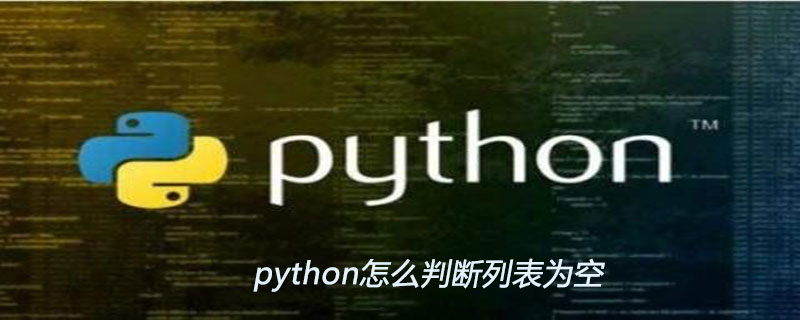How to determine if a list is empty in Python

There is a need to determine whether the list is empty. The method is very simple, for example:
The empty list is equal to False,
then directly if a is Determine the command that needs to be executed when the list is not empty
a = [] if a: COMMAND
Similarly, len(a) = 0
When a is not empty, execute Command
a = [] if len(a): COMMAND
The above is the detailed content of How to determine if a list is empty in Python. For more information, please follow other related articles on the PHP Chinese website!

Hot AI Tools

Undresser.AI Undress
AI-powered app for creating realistic nude photos

AI Clothes Remover
Online AI tool for removing clothes from photos.

Undress AI Tool
Undress images for free

Clothoff.io
AI clothes remover

Video Face Swap
Swap faces in any video effortlessly with our completely free AI face swap tool!

Hot Article

Hot Tools

Notepad++7.3.1
Easy-to-use and free code editor

SublimeText3 Chinese version
Chinese version, very easy to use

Zend Studio 13.0.1
Powerful PHP integrated development environment

Dreamweaver CS6
Visual web development tools

SublimeText3 Mac version
God-level code editing software (SublimeText3)

Hot Topics
 1666
1666
 14
14
 1426
1426
 52
52
 1328
1328
 25
25
 1273
1273
 29
29
 1253
1253
 24
24
 Print list as tabular data in Python
Sep 16, 2023 pm 10:29 PM
Print list as tabular data in Python
Sep 16, 2023 pm 10:29 PM
Data manipulation and analysis are key aspects of programming, especially when working with large data sets. A challenge programmers often face is how to present data in a clear and organized format that facilitates understanding and analysis. Being a versatile language, Python provides various techniques and libraries to print lists as tabular data, thus enabling visually appealing representation of information. Printing a list as tabular data involves arranging the data in rows and columns, similar to a tabular structure. This format makes it easier to compare and understand the relationships between different data points. Whether you are working on a data analysis project, generating reports, or presenting information to stakeholders, being able to print a list as a table in Python is a valuable skill. In this article, we will explore Pytho
 Python program to swap two elements in a list
Aug 25, 2023 pm 02:05 PM
Python program to swap two elements in a list
Aug 25, 2023 pm 02:05 PM
In Python programming, a list is a common and commonly used data structure. They allow us to store and manipulate collections of elements efficiently. Sometimes, we may need to swap the positions of two elements in a list, either to reorganize the list or to perform a specific operation. This blog post explores a Python program that swaps two elements in a list. We will discuss the problem, outline an approach to solving it, and provide a step-by-step algorithm. By understanding and implementing this program, you will be able to manipulate lists and change the arrangement of elements according to your requirements. Understanding the Problem Before we dive into solving the problem, let us clearly define what it means to swap two elements in a list. Swapping two elements in a list means swapping their positions. In other words, I
 Is a Python list mutable or immutable? What about a Python array?
Apr 24, 2025 pm 03:37 PM
Is a Python list mutable or immutable? What about a Python array?
Apr 24, 2025 pm 03:37 PM
Pythonlistsandarraysarebothmutable.1)Listsareflexibleandsupportheterogeneousdatabutarelessmemory-efficient.2)Arraysaremorememory-efficientforhomogeneousdatabutlessversatile,requiringcorrecttypecodeusagetoavoiderrors.
 When would you choose to use an array over a list in Python?
Apr 26, 2025 am 12:12 AM
When would you choose to use an array over a list in Python?
Apr 26, 2025 am 12:12 AM
Useanarray.arrayoveralistinPythonwhendealingwithhomogeneousdata,performance-criticalcode,orinterfacingwithCcode.1)HomogeneousData:Arrayssavememorywithtypedelements.2)Performance-CriticalCode:Arraysofferbetterperformancefornumericaloperations.3)Interf
 Define 'array' and 'list' in the context of Python.
Apr 24, 2025 pm 03:41 PM
Define 'array' and 'list' in the context of Python.
Apr 24, 2025 pm 03:41 PM
InPython,a"list"isaversatile,mutablesequencethatcanholdmixeddatatypes,whilean"array"isamorememory-efficient,homogeneoussequencerequiringelementsofthesametype.1)Listsareidealfordiversedatastorageandmanipulationduetotheirflexibility
 Give an example of a scenario where using a Python array would be more appropriate than using a list.
Apr 28, 2025 am 12:15 AM
Give an example of a scenario where using a Python array would be more appropriate than using a list.
Apr 28, 2025 am 12:15 AM
Using Python arrays is more suitable for processing large amounts of numerical data than lists. 1) Arrays save more memory, 2) Arrays are faster to operate by numerical values, 3) Arrays force type consistency, 4) Arrays are compatible with C arrays, but are not as flexible and convenient as lists.
 What data types can be stored in a Python list?
Apr 30, 2025 am 12:07 AM
What data types can be stored in a Python list?
Apr 30, 2025 am 12:07 AM
Pythonlistscanstoreanydatatype,includingintegers,strings,floats,booleans,otherlists,anddictionaries.Thisversatilityallowsformixed-typelists,whichcanbemanagedeffectivelyusingtypechecks,typehints,andspecializedlibrarieslikenumpyforperformance.Documenti
 How to solve Python's list operation errors?
Jun 25, 2023 am 10:39 AM
How to solve Python's list operation errors?
Jun 25, 2023 am 10:39 AM
As a high-level programming language, Python provides many convenient data structures and operation methods. Among them, list is a very commonly used data structure in Python. It can store data of the same type or different types, and can perform various operations. However, when using Python lists, errors sometimes occur. This article will introduce how to solve Python list operation errors. IndexError (IndexError) In Python, the index of a list starts counting from 0,




